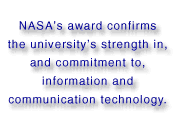NASA's Ames Research Center at Moffett Field, Calif., in the Silicon Valley, has agreed to award $23.3 million to Carnegie Mellon's School of Computer Science to lead the development of a multi-disciplinary, multi-institutional High-Dependability Computing Program (HDCP) to improve NASA's capability to create dependable software.
The incremental, five-year, cooperative agreement is part of a broad strategy for dependable computing that links Carnegie Mellon, NASA, corporate partners and other universities. Carnegie Mellon experts will collaborate with NASA scientists and researchers from the Massachusetts Institute of Technology, University of Maryland, University of Southern California, University of Washington and the University of Wisconsin to measure and improve the
dependability of NASA's systems.
Dependability is a major challenge for all complex software-based systems. Today, there are few effective techniques for measuring dependability and for improving the dependability of large and complex systems. Dependability has many aspects, which include safety-critical reliability, high security, high integrity, continuous operation and human-computer interaction.
Creating dependable software is critical to enable spacecraft to function even when components fail, to keep e-commerce Web sites continuously available, and to prevent unwanted access to sensitive corporate information or tampering with information in an accounting database. One of the
challenges of dependability is measurement.
If there is no way to measure dependability, then a buyer has no way to verify a claim of dependability.
 "While software dependability has been a theme of computing research for several
decades, this program addresses the issue in a new way, looking at the particular challenges of large systems and combining measurement with improvement," said William L. Scherlis, principal research scientist in the Institute for Software Research International in Carnegie Mellon's School of Computer Science. Scherlis and James H. Morris, professor and dean of the School of Computer Science, are principal investigators on the High-Dependability Computing Program.
"While software dependability has been a theme of computing research for several
decades, this program addresses the issue in a new way, looking at the particular challenges of large systems and combining measurement with improvement," said William L. Scherlis, principal research scientist in the Institute for Software Research International in Carnegie Mellon's School of Computer Science. Scherlis and James H. Morris, professor and dean of the School of Computer Science, are principal investigators on the High-Dependability Computing Program.
"We are delighted to work with Carnegie Mellon," said Ames Center Director Dr. Harry McDonald. "Carnegie Mellon is a leader in computing and robotic technologies. We see this as a cornerstone as we move forward with the development of the NASA Research Park."
"This is a unique opportunity to develop
an empirically based science for software dependability and could have a major impact on NASA's ability to rely on complex software for advanced mission capability," said Dr. Michael L. Lowry, chief of research in advanced software engineering technology within the Computational Sciences Division at NASA Ames.
Previous research collaborations between this division and Carnegie Mellon resulted in tools that formally verify artificial intelligence software that autonomously controls robotic spacecraft.
"Human performance and human-computer interaction are critical elements of software reliability," added Dr. Terry Allard, chief of the Human Factors Research and Technology Division at NASA Ames. "These criteria have long been requirements for space and defense systems. Now they are increasingly important for systems in many other sectors of society, including systems
associated with national infrastructure, defense and health care, as well as mainstream systems ranging from electronic commerce to desktops."
"By studying large systems and components important to NASA, we will be better equipped to understand the challenges of moving techniques for measuring and
improving dependability from the laboratory into practice, both for NASA and for the mainstream software development that contributes to the NASA mission," Scherlis said. "The testbed projects will provide
important stepping stones in this process."
Testbed projects, to be announced over the next few months, are likely to include an advanced networking architecture for the International Space Station and NASA's research to improve air-traffic control.
First-year funding for the HDCP is $2.9 million, which will be divided among Carnegie Mellon's Pittsburgh campus, research efforts on the West Coast and
other universities as subcontractors.
The High-Dependability Computing Program is the most recent in a number of important collaborations that Carnegie Mellon has undertaken with NASA. Carnegie Mellon has been working for the past two years to establish a presence in the Silicon Valley. This includes formation of the High-Dependability Computing Consortium (HDCC) jointly with NASA and 15 Silicon Valley companies, focused broadly on reducing failures in computing systems critical to the welfare of society.
Carnegie Mellon has an agreement with NASA to use facilities at Moffett Field to initiate the high-dependability program. "Carnegie Mellon has unique capabilities to offer in Silicon Valley, the information technology capital of the world," said Morris. He believes that Carnegie Mellon's presence in the valley not only makes its offerings more broadly accessible, but also can enhance the educational experience of students at the Pittsburgh campus by giving them opportunities to do internships for research with NASA or Silicon Valley companies. In addition, he said, "Carnegie Mellon has more than 2,500 alumni in Silicon Valley. They want to see us take a more active role in this environment."
In other work with NASA Ames, Carnegie Mellon researchers have developed high-profile robots such as Dante, which explored the interior of a volcano, and
Nomad, which discovered meteorites in Antarctica. In addition, researchers from
departments as diverse as philosophy, computer science, and mechanical engineering have worked with Ames researchers on projects such as formal methods for verifying digital circuitry, vision and navigation, machine learning and data mining.
Return to top
Anne Watzman
(02/05/02)